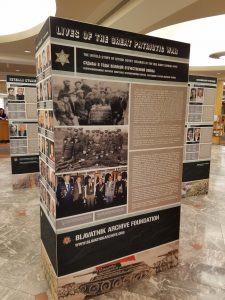By Addison Caruso
When people in the United States tend to think of World War II, the ideas that come to mind are movies such as Saving Private Ryan and heroic American forces defeating evil Nazis on the western front of Europe. While this did occur in World War II, the story of American heroism single-handedly defeating Germany ignores the most instrumental country in the ultimate downfall of Hitler, the Soviet Union. In Russia today, World War II is still referred to as the Great Patriotic War for a reason, for the country bore the brunt of the casualties of the war and was the only force in Europe fighting Nazi Germany until D-Day in 1944. One key component of the Soviet Red Army, and often an overlooked one, were its Jewish soldiers.
At Miami we’ve been fortunate enough to have an exhibit from the Blavatnik Archive in New York City brought to us, detailing some of the heroics of these Jewish soldiers, who fought in this Great Patriotic War. While reading some of the stories I was shocked by what they did and the troubles they went through. It was an entirely different perspective. I, like many other Americans, have heard countless tales of American heroism in World War II, and being a Jewish American, have heard stories of Jewish Americans volunteering to fight. What has been left out of this education, though, has been the telling of the heroism of Russian Jews who fought in the Red Army. For example, Alexandra Bacharova recalls in a testimony the frantic fighting against the Germans they were doing, and despite being surrounded by a hill of dead people, they managed to hold and repel them. I was especially surprised reading this to see that it was a woman who was fighting. To have women actively fighting on the front was something no western country, and certainly not the United States, was doing at the time. It was also something I did not realize, that there were women who put their lives on the line in World War II by fighting on the front.
The exhibit also details another important role the Soviets played in World War II, and that is the one of liberators. Many Nazi concentration camps were located in the east of Europe, with a lot being constructed in Poland, and thus it was ultimately the Soviets who liberated these camps. Reading the testimonials about Jewish soldiers who first realized the horrible atrocities that were being done to their people is awful. One soldier recounted in an interview that while liberating the Majdanek concentration camp, the first concentration camp to be liberated, that he saw a lamp made of human skin. I cannot imagine seeing these sights and possibly knowing people who perished in this camp, as many Soviet Jews were sent off to camps. Another fact the exhibit illuminates is how many Jews were saved by the Soviet Union, though inadvertently. Early on, before the Nazi invasion, Stalin decided to send many Jews eastwards for being involved in illicit small businesses, being engaged in underground politics, or practicing religion when that was not allowed. This policy, though intended to punish the Jewish people, ended up saving many Jews who were concentrated in Western Russia. They say praying can save your life, and I think this is one of the truest examples of this.
Despite their bravery in fighting this war though, perhaps the saddest thing to happen to many of these Soviet patriots was that after the war many were not welcomed back. They were viewed with suspicion, not allowed to return to their old apartments, and kicked out of many jobs that had previously been available to them. The irony of this treatment is overwhelming when one considers that before the war, many Jews felt loyal to the USSR because it had given them much more social mobility than imperial Russia. After 1945, this state turned its back on them. When walking around the exhibit and looking at the photos of people, one can grasp how many who fought ended up leaving the Soviet Union, emigrating to the US and the newly-established state of Israel.
Overall, the Blavatnik Archive exhibit has been very enlightening and informative and by reading it I have learned new things about how much the Soviet Union suffered during this catastrophic war and how many Jews took up the call to arms to defend their homes. I would recommend that everyone visit it and learn a little bit more about an essential piece of history that is often, and unfortunately, neglected.
“War, Revolution, and Jewish Life,” an exhibit sponsored by the Blavatnik Archive, the Havighurst Center for Russian and Post-Soviet Studies, and Hillel at Miami, run through November in King Library.
Addison Caruso is a senior majoring in political science and history.

